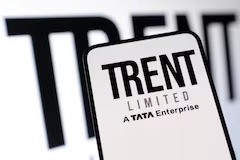 Image Source : Reuters
Image Source : Reuters
HSBC has revised its target price for Trent Ltd. (TRE-N.NS), lowering it from ₹6,600 to ₹6,500 while maintaining a ‘Buy’ rating. The adjustment follows a weaker-than-expected Q1 performance and concerns over sustained high capital expenditure, prompting a more cautious valuation outlook. The move comes amid broader underperformance across Tata Group stocks, with Trent and TCS emerging as the worst-performing Nifty50 constituents in 2025.
Key Highlights from HSBC’s Revision
- Target price cut from ₹6,600 to ₹6,500
- Rating maintained at ‘Buy’ despite valuation adjustment
- Q1 FY26 revenue growth of 20% YoY fell short of HSBC’s 34% expectation
- EPS estimates for FY27 and FY28 lowered by 1% and 2%, respectively
- High annual capex of ₹1,000–₹1,500 crore flagged as a key concern
- Short-term outlook remains muted due to soft demand and sourcing issues
Q1 Performance: Growth Misses Expectations
Trent reported Q1 FY26 revenue of over ₹5,000 crore, marking a 20% year-on-year increase. However, this fell significantly below HSBC’s projected 34% growth, triggering a reassessment of near-term growth potential.
- The company cited soft demand conditions and sourcing disruptions from Bangladesh
- Over 90% of Trent’s products are manufactured in India, but supply chain volatility impacted inventory flow
- Retail sentiment remained subdued amid geopolitical tensions and cautious consumer spending
Despite the miss, HSBC did not alter its revenue or EBITDA estimates, indicating confidence in Trent’s long-term fundamentals.
Capex Concerns and EPS Downgrade
HSBC highlighted Trent’s aggressive expansion strategy as a double-edged sword. While store additions and brand diversification support future growth, the sustained capital outlay has led to a downward revision in earnings projections.
- Annual capex expected to remain in the ₹1,000–₹1,500 crore range for several years
- EPS estimates for FY27 and FY28 cut by 1% and 2%, respectively
- Trent plans to add 250 stores annually across formats including Westside, Zudio, Star, Utsa, and Samoh
- Zudio alone added 220 net stores in FY25, with similar momentum expected this year
HSBC acknowledged the brand’s ability to refresh fashion styles weekly, which helps combat consumer fatigue, but warned that profitability could be impacted by rising competition and operational costs.
Competitive Landscape and Strategic Risks
Trent’s expansion into value fashion and grocery retail has intensified competition with domestic and international players. HSBC flagged several risks:
- Increased competition in the value fast-fashion space may pressure margins
- Star hypermarket’s affordability positioning could cannibalize premium segments
- Sourcing issues and geopolitical instability may continue to affect supply chain efficiency
- Short-term demand outlook remains weak, especially in discretionary categories
The brokerage noted that while Trent’s long-term strategy is sound, the near-term environment warrants a more conservative valuation.
Market Sentiment and Stock Performance
Trent’s stock has declined nearly 30% year-to-date, making it one of the worst-performing Nifty50 stocks in 2025. The downgrade follows similar moves by other brokerages, including Nuvama, which recently cut its rating to ‘Hold’.
- Investor sentiment remains cautious amid broader Tata Group underperformance
- TCS and Trent have both seen significant valuation erosion this year
- Analysts suggest waiting for signs of demand recovery and margin stabilization before re-rating
Despite the dip, Trent’s historical performance—an 800% return over five years—continues to attract long-term investors.
Conclusion
HSBC’s decision to lower Trent’s target price to ₹6,500 reflects a recalibration of expectations in light of Q1 underperformance and sustained capex intensity. While the brokerage maintains a positive long-term view, the muted short-term outlook and competitive pressures have prompted a more conservative stance. For investors, the message is clear: Trent remains a growth story, but one that requires patience and close monitoring.
Source: Financial Express, Economic Times
Advertisement
Advertisement


